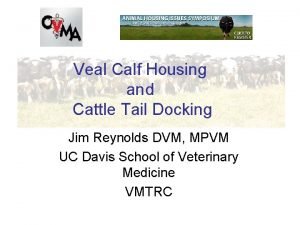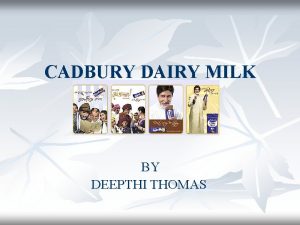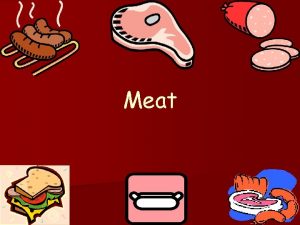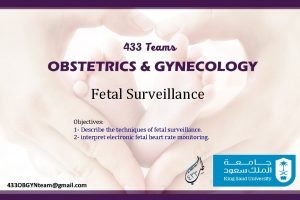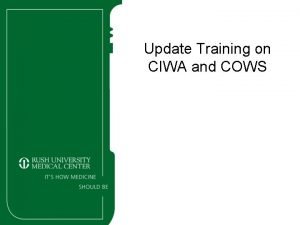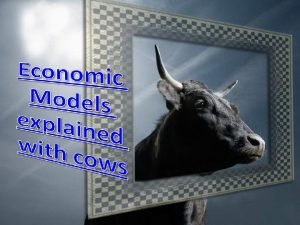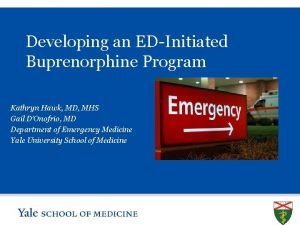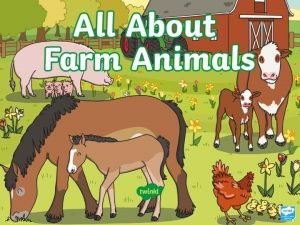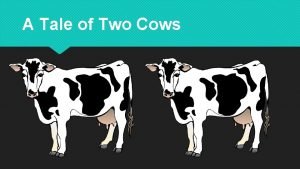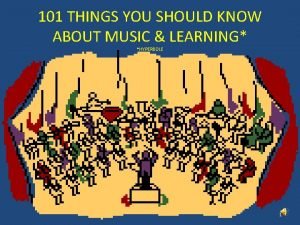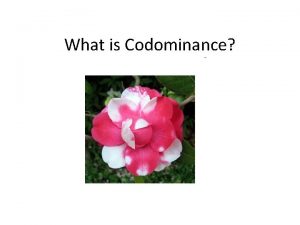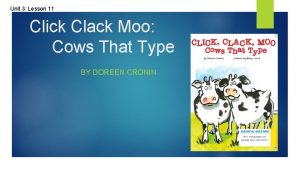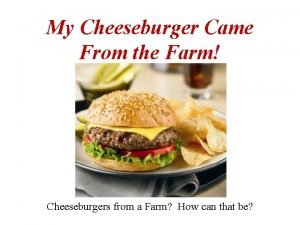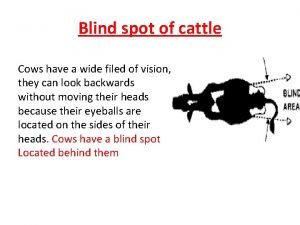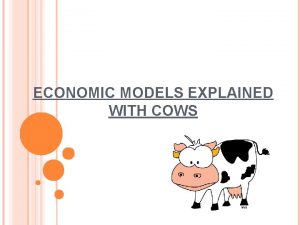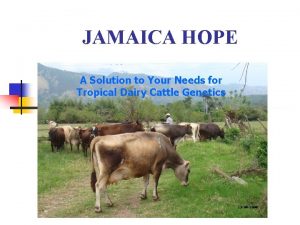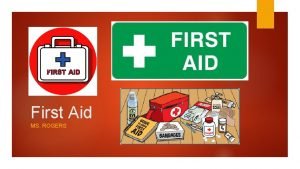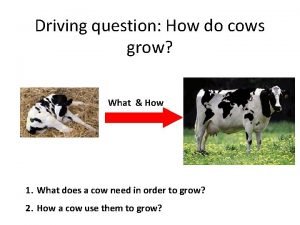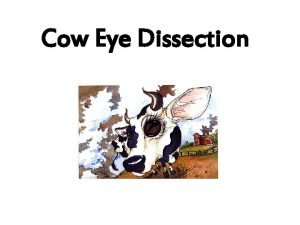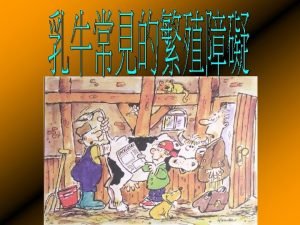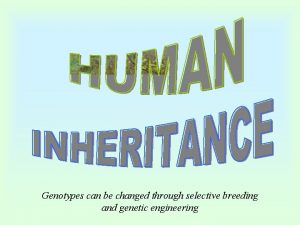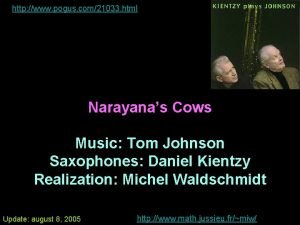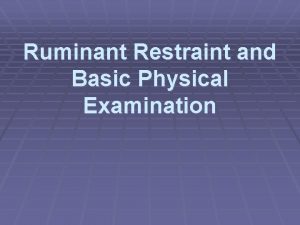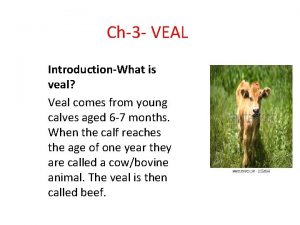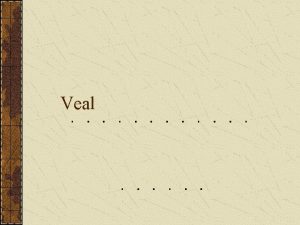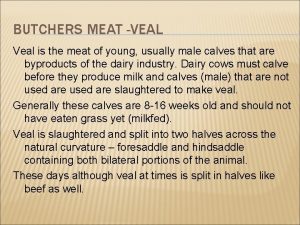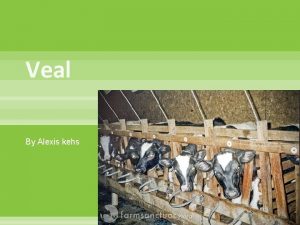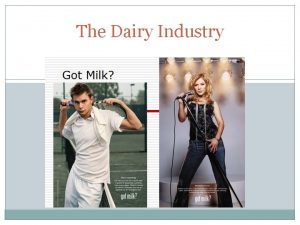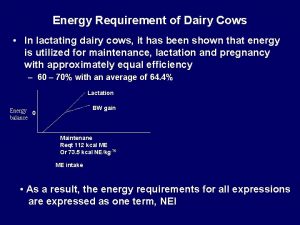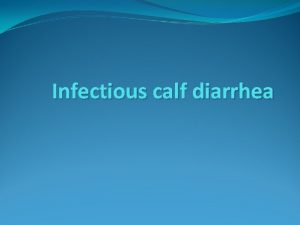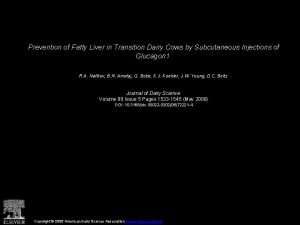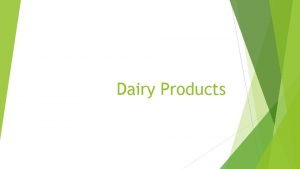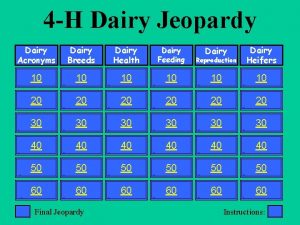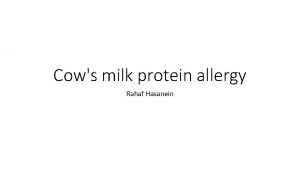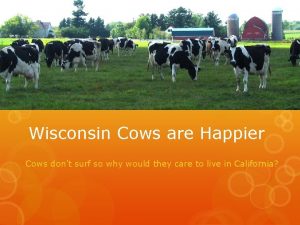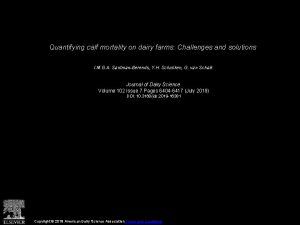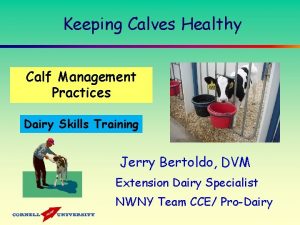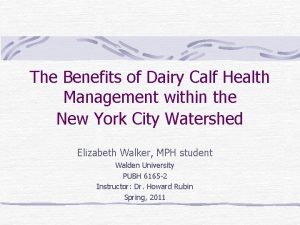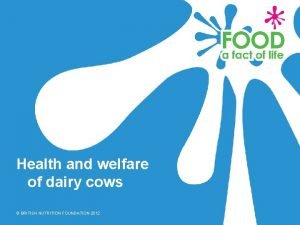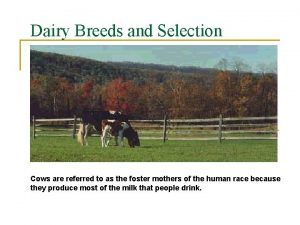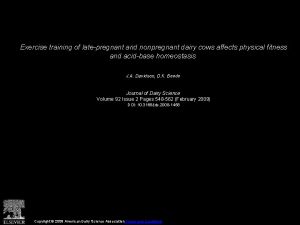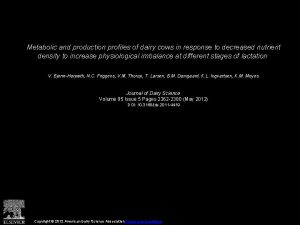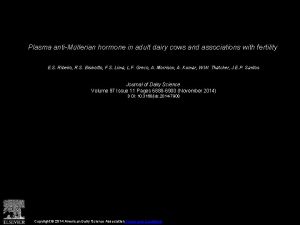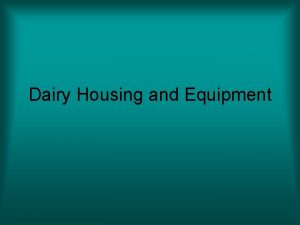Veal Calf Housing Managing Transition Dairy and Cows




































- Slides: 36

Veal Calf Housing Managing Transition Dairy and Cows Cattle Tail Docking Jim Reynolds DVM, MPVM UC Davis School of Veterinary Medicine VMTRC

Dairy Calf Overview Heifer calves Bull calves • Become replacements for 3 uses for dairy bull calves: the dairy • Fed beef • Raised on the dairy or at – Sold to calf ranches a calf ranch – Raised to 4 months – Sold to feedlots • Dairy bulls • Veal calves 2

The Five Freedoms: welfare ideals for farm animals 1 FREEDOM FROM HUNGER AND THIRST by ready access to fresh water and a diet to maintain full health and vigour. 4 FREEDOM TO EXPRESS NORMAL BEHAVIOUR 2 FREEDOM FROM DISCOMFORT 5 FREEDOM FROM FEAR AND DISTRESS by providing an appropriate environment including shelter and a comfortable resting area. by providing sufficient space, proper facilities and company of the animal’s own kind. by ensuring conditions and treatment which avoid mental suffering. 3 FREEDOM FROM PAIN, INJURY OR DISEASE by prevention or rapid diagnosis and treatment. 3

Animal Husbandry = Animal Welfare 1) Nutrition – feed and water 2) Housing – cow comfort; clean, dry, comfortable housing 3) Health – disease prevention, recognition and treatment 4) Animal behavior and social interaction 5) Minimal stress – calm handling and secure housing 4

Basic behaviors of calves include: • • Resting / lying Standing Eating Drinking • • Ruminating Walking Playing Grooming From: Calf Welfare. Stull and Reynolds 5

Animals have certain innate behaviors The question to ask yourself is: Does the environment or management system we provide restrict their ability to express those behaviors? In as much as is possible – the objective should be to provide an environment that permits normal behavior, provides basic animal needs and limits or reduces fear and distress. J. K. Shearer DVM, MS. Professor and Extension Veterinarian Iowa State University College of Veterinary Medicine JKS@iastate. edu

Calf Needs and Natural Behaviors • Suckling behavior – Nipple bottle versus bucket feeding? • Resting or sleeping – Tethered housing? Pens that restrict ability to turn around • Need to explore and socialize – Individual pens or stalls • The need for exercise – How much space? • Grooming behavior – Individual housing restricts grooming behavior

Normal Resting Positions The Narrow Resting Position The Long Resting Position The Wide Resting Position The Short Resting Position

Basic Dairy Calf Housing Neonates / Individual housing: • Must be clean and dry • Calves must be able to turn around in individual housing – “Turn around without touching sides”? – “Extend feet without touching sides”? • Nesting (bedding) in cold weather • Calf-calf interaction • Tether OK if can turn around 9

Individual Dairy Calf Housing Typical for first 60 days positives negatives • Provides shelter from sun • Limits movement to and rain turning around and lying • Allows contact with • Does not allow play adjacent calves • Allows grooming and most lying postures • Facilitates observation, vaccination and treatment • Facilitates contagious disease control 10

Neonates / Group housing: positives negatives • Provides stimulation and enrichment • Allows calf play • Increased calf to calf interaction • Allows all postures • Well suited for small groups • Sanitation can be difficult with large groups • Contagious disease control procedures more difficult 11

Veal Calf Production and Welfare - Industry Facts • Six primary veal producing states - Indiana, Michigan, New York, Ohio, Pennsylvania and Wisconsin. • Veal farmers purchase surplus dairy calves, primarily male Holstein calves, at about 100 pounds live weight and raise them for approximately 18 -20 weeks, until they weigh upward of 475 -500 pounds. From American Veal Association http: //www. vealfarm. com/industry-info/facts. asp 12

Veal Calf Production and Welfare - Industry Facts • Typical farm has 250 calves, cared for by a farm family. • Special-fed veal represents a $650 - $700 million industry. • The special-fed veal industry contributes $250 million to the dairy industry through purchases of dairy by-products and calves. From American Veal Association http: //www. vealfarm. com/industry-info/facts. asp 13

What is “Veal”? • • Soft, tender pale meat of young calves Calves are 1 day to 5 months of age Color of meat is determined by iron and copper Exercise is reduced in the belief it softens the meat • Kept monogastric in belief that rumen fermentation changes flavor and texture of the meat • “flavor and texture is imparted by the chef” 14

Veal Calf Production and Welfare Several categories of veal calves: • “Bob veal” – 1 day to a few weeks of age • Veal – Typically 5 months and 500 pounds • Special-fed veal – Rose or pink veal – More iron and copper in calf – “Red veal” 15

“Classic” Veal Production Welfare Issues • Calves are not castrated or dehorned (a welfare positive) • Tethered in place – Cannot turn around or contact other calves – Short tether does not allow normal movement • Fed liquid only (milk replacer) diet – Rumen not developed; no cud-chewing – Rumen development can be considered normal physiology 16

Welfare Issues with “Traditional Veal” • Behavior – Limited or no contact with other calves – Stereotypy of licking side (excessive grooming) from lack of rumination or suckling • “hair balls” in abomasum (bezoar) • Deficient in iron – Iron for calf comes from soil – Intended to reduce hemoglobin • Housed on raised floors to prevent eating dirt (iron) – Wooden slated floors can damage knees as calf gets heavy • Indoors, often in dark rooms 17

EU Regulations for Humane Veal Production • Housed in groups after 8 weeks of age – Allows calf interaction (play) • Fed dry feed to cause rumen development – Considered normal physiology • Iron fed or injected 18

Current Veal Production in the US “Veal farmers are ahead of schedule as they work to meet the American Veal Association (AVA) commitment to transition all veal farms to group housing by 2017. An April survey found that 34. 8 percent of the veal calves currently going to market are raised in group-housing facilities. ” “In May 2007, the AVA’s board of directors voted unanimously to adopt a resolution calling for all U. S. veal farms to transition to group-housing systems by Dec. 31, 2017. The board also encouraged more research to aid farmers in the transition. ” • Veal calves move to group housing By Dairy Herd news source | Monday, June 08, 2009 19

Current Veal Production in the US “Animal Care: We have an ethical obligation to provide appropriate care for our animals at every stage of life Veal Producers are expected to: – Safeguard and promote the health and well-being of animals in their care – Provide appropriate water, food, shelter, handling and transportation at all times – Respect the special considerations and needs of young calves – Provide appropriate veterinary care at all stages of life, and when necessary timely euthanasia. ” • http: //www. vealfarm. com/vqap/index. asp#vqa 20

AVMA policy: Veal Calf Management • Individual housing during the neonatal period facilitates sanitation, disease control and individual attention for observation and treatment. Individual housing must allow the calf to turn around comfortably and to assume normal postures. • http: //www. avma. org/issues/policy/animal_welfare/veal_calf_management. asp 21

AVMA policy: Veal Calf Management • Calves should be housed in groups by 10 weeks of age to facilitate normal behaviors, including social interaction. Like individual housing, group housing must allow all calves to turn around comfortably and to assume normal postures. • http: //www. avma. org/issues/policy/animal_welfare/veal_calf_management. asp 22

AVMA policy: Veal Calf Management • Calves must be fed diets that provide adequate energy, protein and minerals to maintain good health and positive growth. Diets must be balanced to prevent nutritional deficiencies and their consequences, including but not limited to iron deficiency with subsequent anemia. Water must be provided from birth. Dry feed must be provided for rumen development and to allow the normal process of rumination. All calves must be fed colostrum after birth. • http: //www. avma. org/issues/policy/animal_welfare/veal_calf_management. asp 23

AVMA policy: Veal Calf Management • Housing must be ventilated to provide fresh air and to prevent buildup of ammonia or pathogens. Floors and bedding must be clean, dry and maintained to prevent injuries, and allow calves to maintain normal body temperature in cold weather. • http: //www. avma. org/issues/policy/animal_welfare/veal_calf_management. asp 24

Tail Docking of Cattle

Cattle Tail Docking Summary history of cattle tail docking: • Began in New Zealand with erroneous association with Leptospirosis in people – Cows get different Leptospires than people • Considered to control mastitis – Increased manure on tail thought to be associated with increased mastitis • Was brought to USA to control Somatic Cell Count when r. BST introduced 26

Cattle Tail Docking Reasoning behind tail docking in cattle: Cows get excessive manure on tails Manure on tails transferred to udder Cows get mastitis Cut off tails 27

“The cow has a tail for a purpose” • Communication / behavioral – Signaling other cows and calves (and people) – Estrus activity • Fly control “The cow has a tail for a purpose” Tail Docking Dairy Cattle Animal Welfare Institute http: //www. ohiovma. org/ (6 -2010) – Eicher, S. D. , and J. W. Dailey. 2002. Indicators of acute pain and fly avoidance behavior in Holstein calves following tail-docking. J. Dairy Sci. 85: 2850– 2858. • Temperature control 28

Methods of docking cattle tails • Elastrator band – Placed below level of vulva – Weeks old to adult • Pruning shears • Burdizzo (? ) 29

Welfare issues associated with tail docking • Acute pain – Pain at time of docking and until healed • Residual pain – chronic pain – Increased response to cold – Neuromas similar to people with severed limbs • “Phantom pain” • Fly avoidance • Signaling behavior 30

Painful procedures If a procedure will cause pain: 1) is the procedure necessary for the cow or society (i. e. a benefit)? 2) if the procedure will cause pain and is necessary, then pain management must be considered. 31

Benefits from tail docking • Not associated with mastitis control or lower Somatic Cell Count – “No significant differences were observed in SCC, udder cleanliness, or intramammary infection between docked and intact cattle. 10 Although docked cattle had a higher incidence of mastitis in one study, 9 the difference was not statistically significant. ” AVMA Tail Docking Backgrounder for references http: //www. avma. org/reference/backgrounders/tail_dock ing_cattle_bgnd. asp http: //www. ohiovma. org/ 32

Benefits from tail docking • Potential ease when milking / human comfort 33

AVMA policy: Tail Docking of Cattle The AVMA opposes routine tail docking of cattle. Current scientific literature indicates that routine tail docking provides no benefit to the animal, and that tail docking can lead to distress during fly seasons. When medically necessary, amputation of tails must be performed by a licensed veterinarian. (Oversight: AWC; EB 04/2004; reaffirmed 04/2009) 34

State Legislation re: Bovine Tail docking • SB 135: prohibited tail docking cattle in California as of January 1, 2010 – Presented by HSUS 35

Alternatives to tail docking • Provide clean, dry housing and bedding – Sanitation the most important factor in cow and calf health – Mastitis control is keeping the housing clean • Trim switch 36
 Veal calf housing
Veal calf housing Deepthi thomas
Deepthi thomas Types of veal
Types of veal Veal chop fht
Veal chop fht Produk hasil peternakan
Produk hasil peternakan Ciwa
Ciwa Plural noun of calf
Plural noun of calf You have 2 cows
You have 2 cows Peripheral vs central vertigo
Peripheral vs central vertigo Cows test nystagmus
Cows test nystagmus Hawk d'onofrio
Hawk d'onofrio What cows give us
What cows give us Anatomy of female cow reproductive system
Anatomy of female cow reproductive system You have two cows
You have two cows Every good boy does fine all cows eat grass
Every good boy does fine all cows eat grass What is codominance? *
What is codominance? * Click clack moo cows that type comprehension questions
Click clack moo cows that type comprehension questions Parts of a cows stomach
Parts of a cows stomach Where is a cows blind spot
Where is a cows blind spot Communism explained with cows
Communism explained with cows Cows in jamaica
Cows in jamaica Drsabcd worksheet
Drsabcd worksheet How do cows grow
How do cows grow Optic disc of cow eye
Optic disc of cow eye Cows near an electric fence einstein
Cows near an electric fence einstein Political ideologies cows
Political ideologies cows Marketing midterm review
Marketing midterm review You have two cows
You have two cows Uterine tonus
Uterine tonus Hormones in cows
Hormones in cows Cow is a herbivore or omnivore
Cow is a herbivore or omnivore Narayana's cows sequence
Narayana's cows sequence Hlsr calf scramble stall displays
Hlsr calf scramble stall displays Flank rope cattle
Flank rope cattle Bell ringer figurative language
Bell ringer figurative language Calf milk pasteurizer
Calf milk pasteurizer Toe dancers muscle a two bellied muscle of the calf
Toe dancers muscle a two bellied muscle of the calf
